6.12: Chords and Central Angle Arcs
- Page ID
- 5027
\( \newcommand{\vecs}[1]{\overset { \scriptstyle \rightharpoonup} {\mathbf{#1}} } \)
\( \newcommand{\vecd}[1]{\overset{-\!-\!\rightharpoonup}{\vphantom{a}\smash {#1}}} \)
\( \newcommand{\dsum}{\displaystyle\sum\limits} \)
\( \newcommand{\dint}{\displaystyle\int\limits} \)
\( \newcommand{\dlim}{\displaystyle\lim\limits} \)
\( \newcommand{\id}{\mathrm{id}}\) \( \newcommand{\Span}{\mathrm{span}}\)
( \newcommand{\kernel}{\mathrm{null}\,}\) \( \newcommand{\range}{\mathrm{range}\,}\)
\( \newcommand{\RealPart}{\mathrm{Re}}\) \( \newcommand{\ImaginaryPart}{\mathrm{Im}}\)
\( \newcommand{\Argument}{\mathrm{Arg}}\) \( \newcommand{\norm}[1]{\| #1 \|}\)
\( \newcommand{\inner}[2]{\langle #1, #2 \rangle}\)
\( \newcommand{\Span}{\mathrm{span}}\)
\( \newcommand{\id}{\mathrm{id}}\)
\( \newcommand{\Span}{\mathrm{span}}\)
\( \newcommand{\kernel}{\mathrm{null}\,}\)
\( \newcommand{\range}{\mathrm{range}\,}\)
\( \newcommand{\RealPart}{\mathrm{Re}}\)
\( \newcommand{\ImaginaryPart}{\mathrm{Im}}\)
\( \newcommand{\Argument}{\mathrm{Arg}}\)
\( \newcommand{\norm}[1]{\| #1 \|}\)
\( \newcommand{\inner}[2]{\langle #1, #2 \rangle}\)
\( \newcommand{\Span}{\mathrm{span}}\) \( \newcommand{\AA}{\unicode[.8,0]{x212B}}\)
\( \newcommand{\vectorA}[1]{\vec{#1}} % arrow\)
\( \newcommand{\vectorAt}[1]{\vec{\text{#1}}} % arrow\)
\( \newcommand{\vectorB}[1]{\overset { \scriptstyle \rightharpoonup} {\mathbf{#1}} } \)
\( \newcommand{\vectorC}[1]{\textbf{#1}} \)
\( \newcommand{\vectorD}[1]{\overrightarrow{#1}} \)
\( \newcommand{\vectorDt}[1]{\overrightarrow{\text{#1}}} \)
\( \newcommand{\vectE}[1]{\overset{-\!-\!\rightharpoonup}{\vphantom{a}\smash{\mathbf {#1}}}} \)
\( \newcommand{\vecs}[1]{\overset { \scriptstyle \rightharpoonup} {\mathbf{#1}} } \)
\( \newcommand{\vecd}[1]{\overset{-\!-\!\rightharpoonup}{\vphantom{a}\smash {#1}}} \)
\(\newcommand{\avec}{\mathbf a}\) \(\newcommand{\bvec}{\mathbf b}\) \(\newcommand{\cvec}{\mathbf c}\) \(\newcommand{\dvec}{\mathbf d}\) \(\newcommand{\dtil}{\widetilde{\mathbf d}}\) \(\newcommand{\evec}{\mathbf e}\) \(\newcommand{\fvec}{\mathbf f}\) \(\newcommand{\nvec}{\mathbf n}\) \(\newcommand{\pvec}{\mathbf p}\) \(\newcommand{\qvec}{\mathbf q}\) \(\newcommand{\svec}{\mathbf s}\) \(\newcommand{\tvec}{\mathbf t}\) \(\newcommand{\uvec}{\mathbf u}\) \(\newcommand{\vvec}{\mathbf v}\) \(\newcommand{\wvec}{\mathbf w}\) \(\newcommand{\xvec}{\mathbf x}\) \(\newcommand{\yvec}{\mathbf y}\) \(\newcommand{\zvec}{\mathbf z}\) \(\newcommand{\rvec}{\mathbf r}\) \(\newcommand{\mvec}{\mathbf m}\) \(\newcommand{\zerovec}{\mathbf 0}\) \(\newcommand{\onevec}{\mathbf 1}\) \(\newcommand{\real}{\mathbb R}\) \(\newcommand{\twovec}[2]{\left[\begin{array}{r}#1 \\ #2 \end{array}\right]}\) \(\newcommand{\ctwovec}[2]{\left[\begin{array}{c}#1 \\ #2 \end{array}\right]}\) \(\newcommand{\threevec}[3]{\left[\begin{array}{r}#1 \\ #2 \\ #3 \end{array}\right]}\) \(\newcommand{\cthreevec}[3]{\left[\begin{array}{c}#1 \\ #2 \\ #3 \end{array}\right]}\) \(\newcommand{\fourvec}[4]{\left[\begin{array}{r}#1 \\ #2 \\ #3 \\ #4 \end{array}\right]}\) \(\newcommand{\cfourvec}[4]{\left[\begin{array}{c}#1 \\ #2 \\ #3 \\ #4 \end{array}\right]}\) \(\newcommand{\fivevec}[5]{\left[\begin{array}{r}#1 \\ #2 \\ #3 \\ #4 \\ #5 \\ \end{array}\right]}\) \(\newcommand{\cfivevec}[5]{\left[\begin{array}{c}#1 \\ #2 \\ #3 \\ #4 \\ #5 \\ \end{array}\right]}\) \(\newcommand{\mattwo}[4]{\left[\begin{array}{rr}#1 \amp #2 \\ #3 \amp #4 \\ \end{array}\right]}\) \(\newcommand{\laspan}[1]{\text{Span}\{#1\}}\) \(\newcommand{\bcal}{\cal B}\) \(\newcommand{\ccal}{\cal C}\) \(\newcommand{\scal}{\cal S}\) \(\newcommand{\wcal}{\cal W}\) \(\newcommand{\ecal}{\cal E}\) \(\newcommand{\coords}[2]{\left\{#1\right\}_{#2}}\) \(\newcommand{\gray}[1]{\color{gray}{#1}}\) \(\newcommand{\lgray}[1]{\color{lightgray}{#1}}\) \(\newcommand{\rank}{\operatorname{rank}}\) \(\newcommand{\row}{\text{Row}}\) \(\newcommand{\col}{\text{Col}}\) \(\renewcommand{\row}{\text{Row}}\) \(\newcommand{\nul}{\text{Nul}}\) \(\newcommand{\var}{\text{Var}}\) \(\newcommand{\corr}{\text{corr}}\) \(\newcommand{\len}[1]{\left|#1\right|}\) \(\newcommand{\bbar}{\overline{\bvec}}\) \(\newcommand{\bhat}{\widehat{\bvec}}\) \(\newcommand{\bperp}{\bvec^\perp}\) \(\newcommand{\xhat}{\widehat{\xvec}}\) \(\newcommand{\vhat}{\widehat{\vvec}}\) \(\newcommand{\uhat}{\widehat{\uvec}}\) \(\newcommand{\what}{\widehat{\wvec}}\) \(\newcommand{\Sighat}{\widehat{\Sigma}}\) \(\newcommand{\lt}{<}\) \(\newcommand{\gt}{>}\) \(\newcommand{\amp}{&}\) \(\definecolor{fillinmathshade}{gray}{0.9}\)Arcs determined by angles whose vertex is the center of a circle and chords (segments that connect two points on a circle).
Chords in Circles
Chord Theorems
There are several important theorems about chords that will help you to analyze circles better.
1. Chord Theorem #1: In the same circle or congruent circles, minor arcs are congruent if and only if their corresponding chords are congruent.
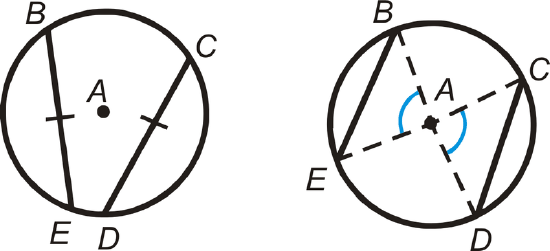
In both of these pictures, \(\overline{BE}\cong \overline{CD}\) and \(\widehat{BE}\cong \widehat{CD}\).
2. Chord Theorem #2: The perpendicular bisector of a chord is also a diameter.
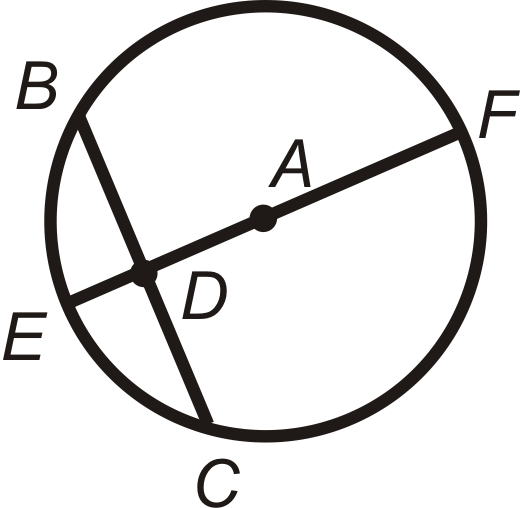
If \(\overline{AD}\perp \overline{BC}\) and \(\overline{BD}\cong \overline{DC}\) then \(\overline{EF}\) is a diameter.
3. Chord Theorem #3: If a diameter is perpendicular to a chord, then the diameter bisects the chord and its corresponding arc.

If \(\overline{EF}\perp \overline{BC}\), then \(\overline{BD}\cong \overline{DC}\)
4. Chord Theorem #4: In the same circle or congruent circles, two chords are congruent if and only if they are equidistant from the center.
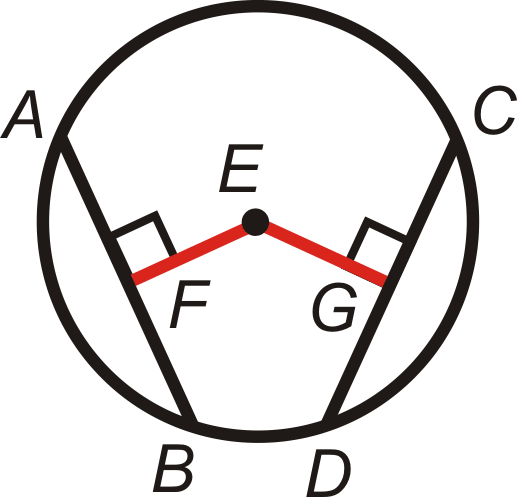
The shortest distance from any point to a line is the perpendicular line between them. If \(FE=EG\) and \(\overline{EF}\perp \overline{EG}\), then \(\overline{AB}\) and \(\overline{CD}\) are equidistant to the center and\(\overline{AB}\cong \overline{CD}\).
What if you were given a circle with two chords drawn through it? How could you determine if these two chords were congruent?
Example \(\PageIndex{1}\)
Find the value of \(x\) and \(y\).
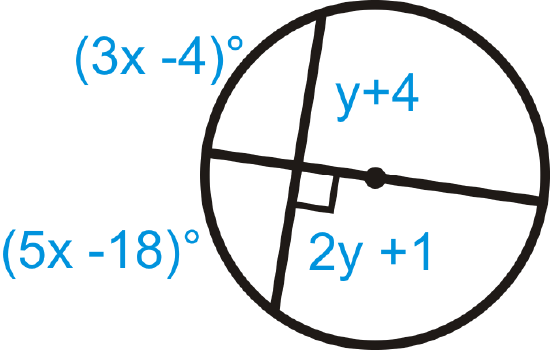
Solution
The diameter is perpendicular to the chord, which means it bisects the chord and the arc. Set up equations for \(x\) and \(y\).
\(\begin{array}{rlr}
(3 x-4)^{\circ} & =(5 x-18)^{\circ} & y+4=2 y+1 \\
14 & =2 x & 3=y \\
7 & =x
\end{array}\)
Example \(\PageIndex{2}\)
\(BD=12\) and \(AC=3\) in \(\bigodot A\). Find the radius.
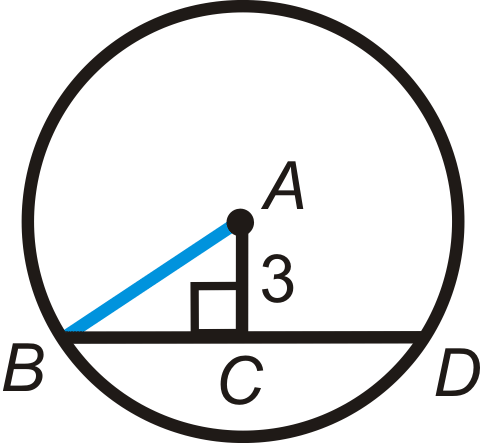
Solution
First find the radius. \(\overline{AB}\) is a radius, so we can use the right triangle \Delta ABC\) with hypotenuse \(\overline{AB}\). From Chord Theorem #3, \(BC=6\).
\(\begin{aligned} 3^2+6^2&=AB^2 \\ 9+36&=AB^2 \\ AB&=\sqrt{45}=3\sqrt{5}\end{aligned}\)
Example \(\PageIndex{3}\)
Use \(\bigodot A\) to answer the following.
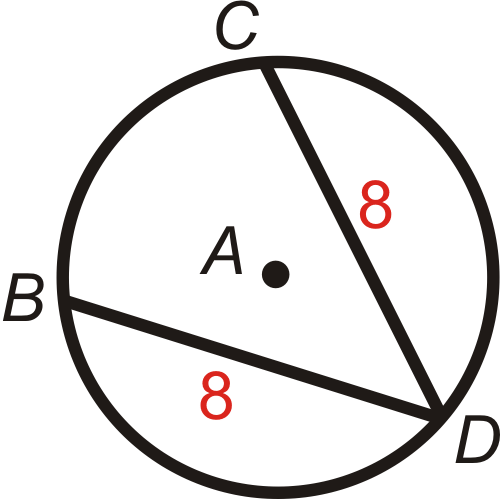
- If \(m\widehat{BD}=125^{\circ}\), find \(m\widehat{CD}\).
- If \(m\widehat{BC}=80^{\circ}\), find \(m\widehat{CD}\).
Solution
- \(BD=CD\), which means the arcs are congruent too. \(m\widehat{CD}=125^{\circ}\).
- \(m\widehat{CD}\cong m\widehat{BD}\) because \(BD=CD\).
\(\begin{aligned} m\widehat{BC}+m\widehat{CD}+m\widehat{BD}&=360^{\circ} \\ 80^{\circ}+2m\widehat{CD}&=360^{\circ} \\ 2m\widehat{CD}&=280^{\circ} \\ m\widehat{CD}=140^{\circ}\end{aligned}\)
Example \(\PageIndex{4}\)
Find the values of \(x\) and \(y\).
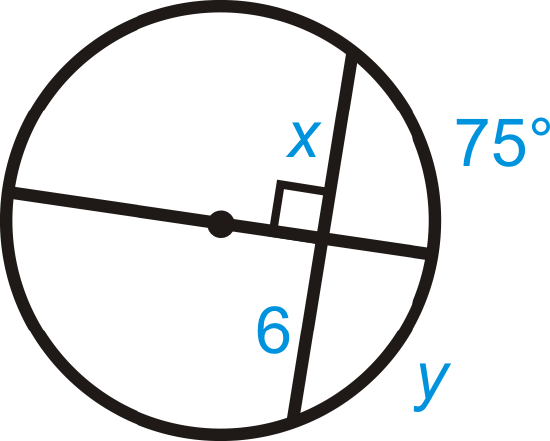
Solution
The diameter is perpendicular to the chord. From Chord Theorem #3, \(x=6\) and \(y=75^{\circ}\).
Example \(\PageIndex{5}\)
Find the value of \(x\).
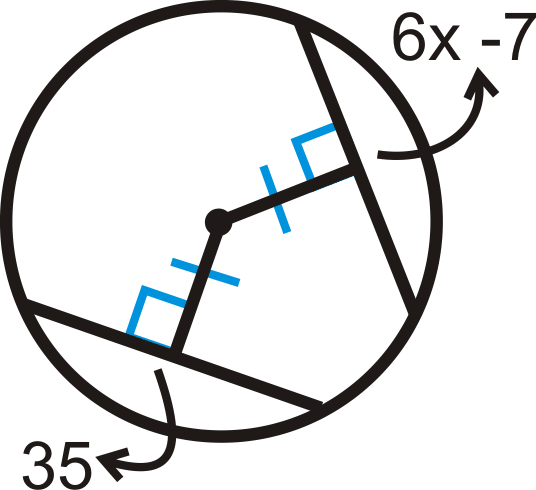
Solution
Because the distance from the center to the chords is equal, the chords are congruent.
\(\begin{aligned} 6x−7&=35 \\ 6x&=42 \\ x&=7 \end{aligned}\)
Review
Fill in the blanks.
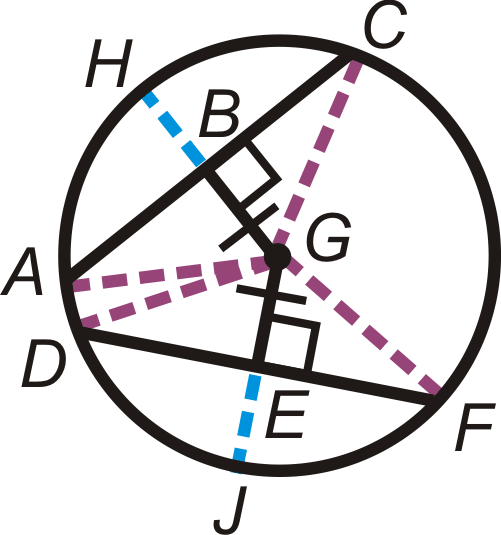
- \(\text{_____}\cong \overline{DF}\)
- \(\widehat{AC} \cong \text{_____}\)
- \(\widehat{DJ}\cong \text{_____}\)
- \(\text{_____}\cong \overline{EJ}\)
- \(\angle AGH\cong \text{_____}\)
- \(\angle DGF\cong \text{_____}\)
- List all the congruent radii in \(\bigodot G\).
Find the value of the indicated arc in \(\bigodot A\).
- \(m\widehat{BC}\)
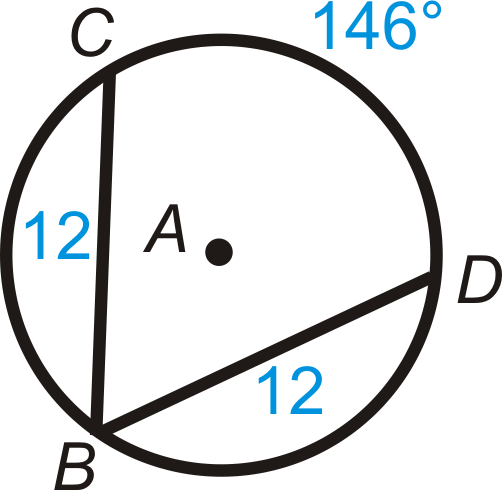
Figure \(\PageIndex{11}\) - \(m\widehat{BD}\)

Figure \(\PageIndex{12}\) - \(m\widehat{BC}\)
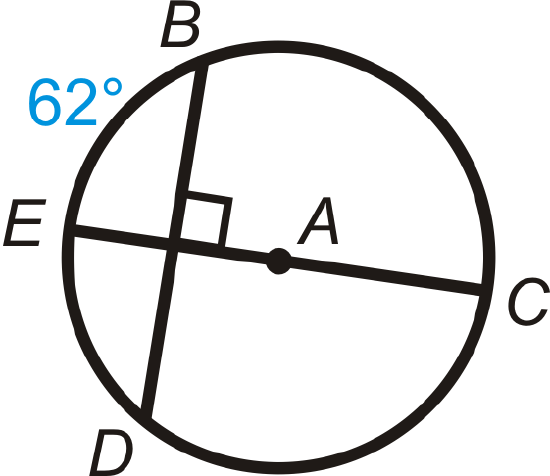
Figure \(\PageIndex{13}\) - \(m\widehat{BD}\)
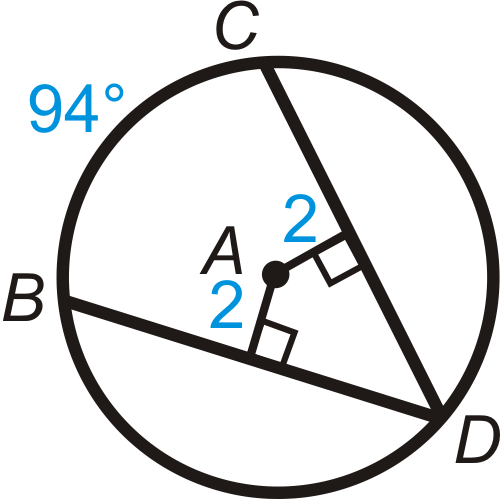
Figure \(\PageIndex{14}\) - \(m\widehat{BD} \)
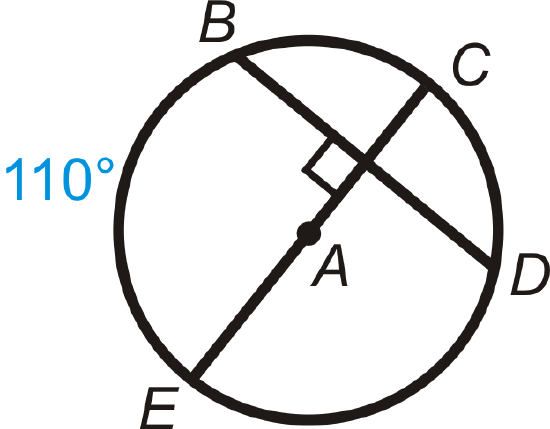
Figure \(\PageIndex{15}\) - \(m\widehat{BD}\)

Figure \(\PageIndex{16}\)
Find the value of \(x\) and/or \(y\).
-
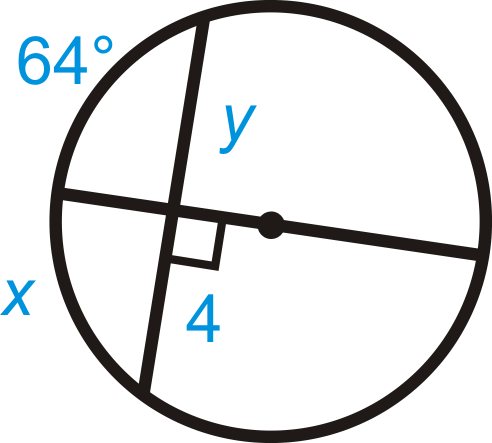
Figure \(\PageIndex{17}\) -
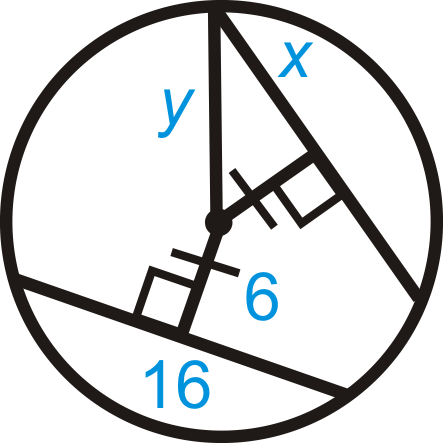
Figure \(\PageIndex{18}\) -
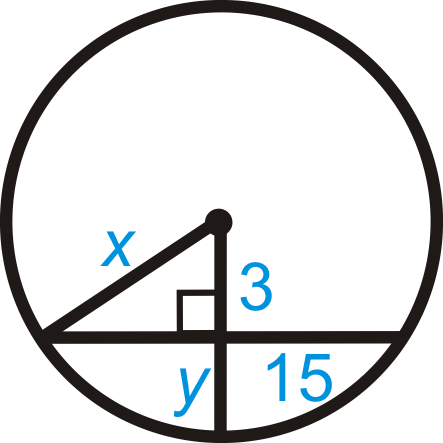
Figure \(\PageIndex{19}\) - \(AB=32\)
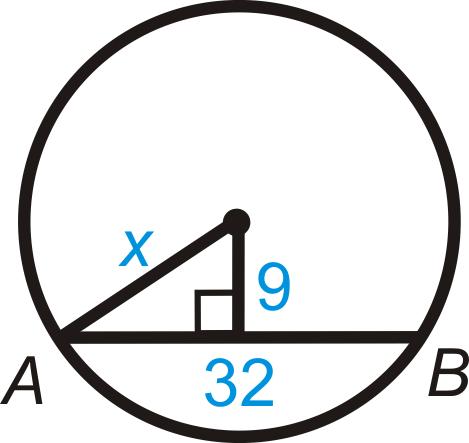
Figure \(\PageIndex{20}\) -
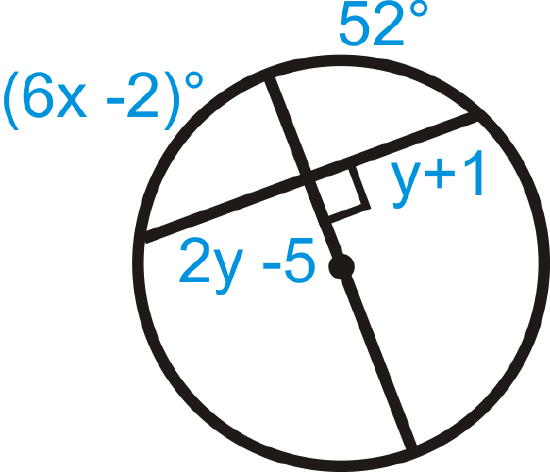
Figure \(\PageIndex{21}\) -

Figure \(\PageIndex{22}\) -
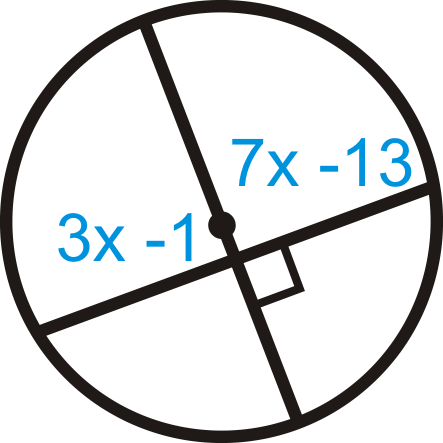
Figure \(\PageIndex{23}\) -
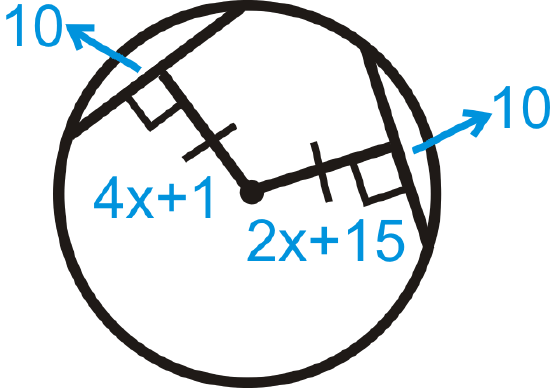
Figure \(\PageIndex{24}\) - \(AB=20\)
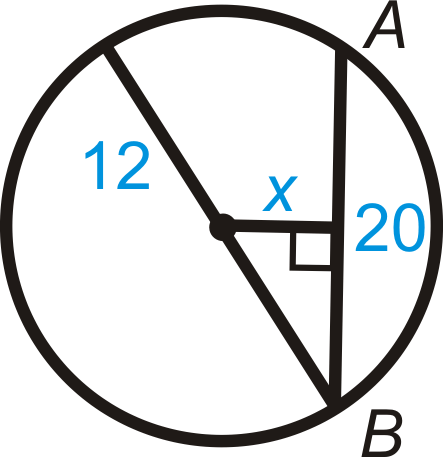
Figure \(\PageIndex{25}\) - Find \(m\widehat{AB}\) in Question 17. Round your answer to the nearest tenth of a degree.
- Find \(m\widehat{AB}\) in Question 22. Round your answer to the nearest tenth of a degree.
In problems 25-27, what can you conclude about the picture? State a theorem that justifies your answer. You may assume that A is the center of the circle.
-
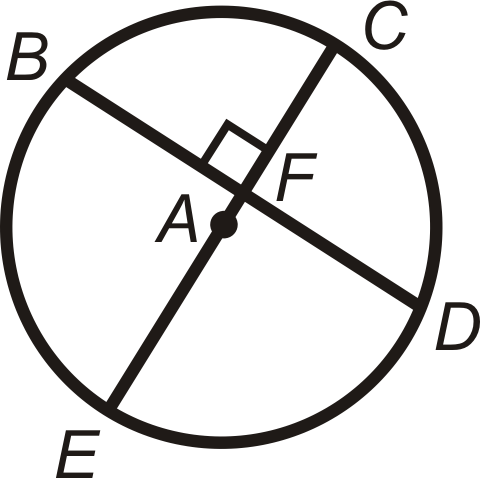
Figure \(\PageIndex{26}\) -
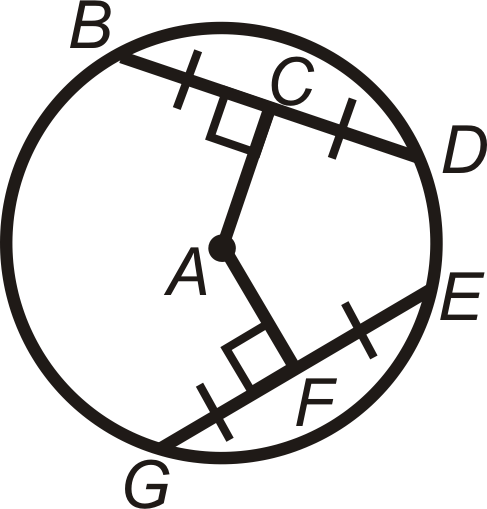
Figure \(\PageIndex{27}\) -
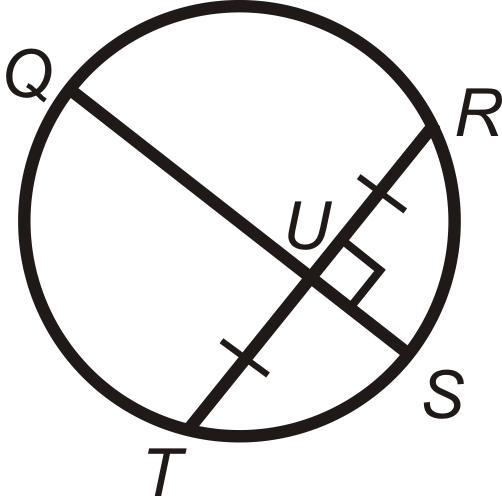
Figure \(\PageIndex{28}\)
Review (Answers)
To see the Review answers, open this PDF file and look for section 9.4.
Vocabulary
| Term | Definition |
|---|---|
| chord | A line segment whose endpoints are on a circle. |
| circle | The set of all points that are the same distance away from a specific point, called the center. |
| diameter | A chord that passes through the center of the circle. The length of a diameter is two times the length of a radius. |
| radius | The distance from the center to the outer rim of a circle. |
Additional Resources
Interactive Element
Video: Chords in Circles Principles - Basic
Activities: Chords in Circles Discussion Questions
Study Aids: Circles: Segments and Lengths Study Guide
Practice: Chords and Central Angle Arcs

